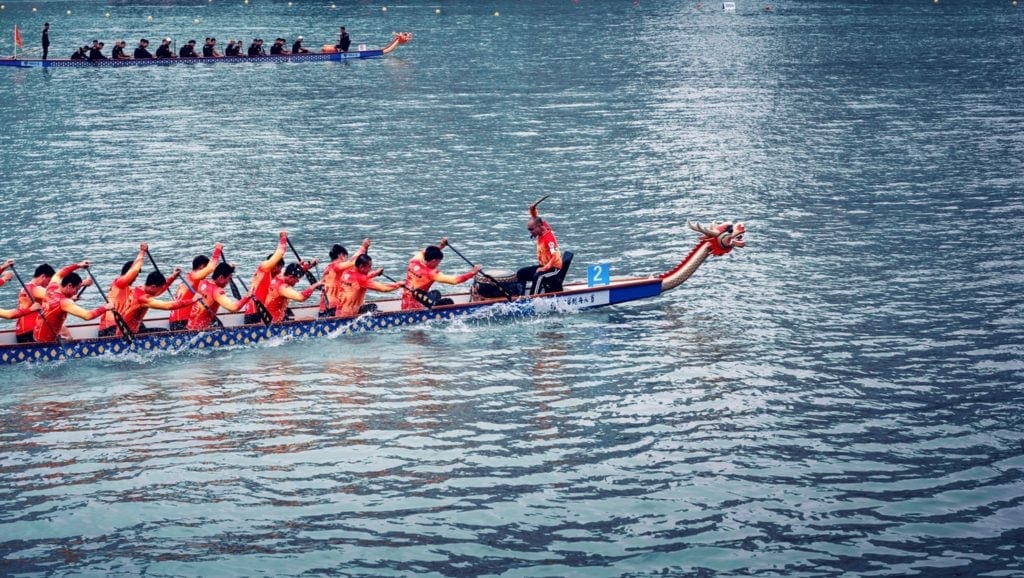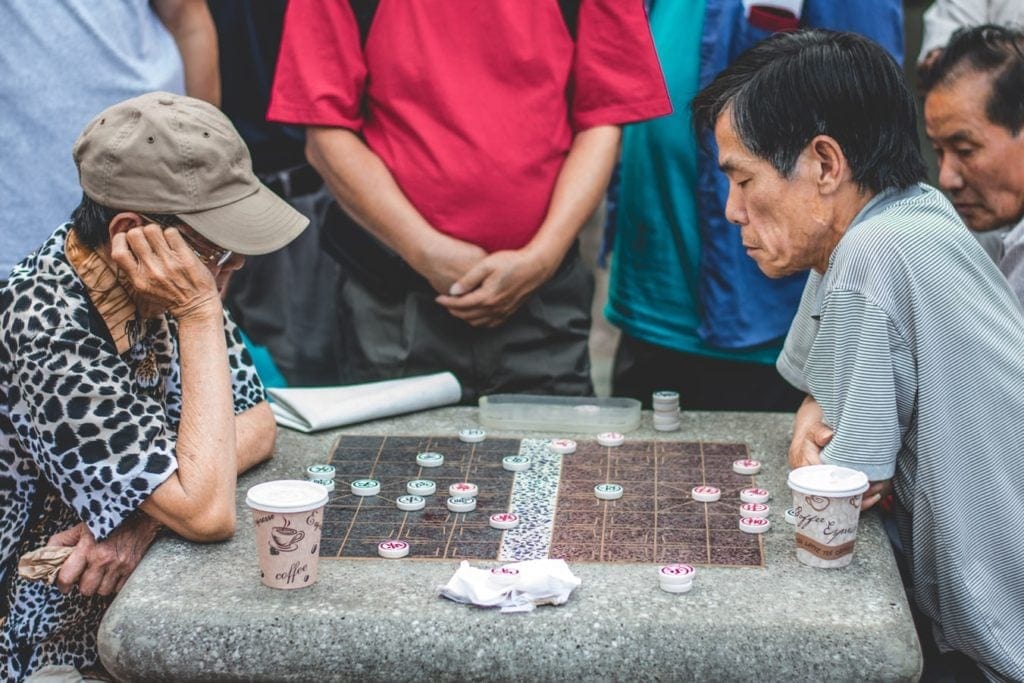You might have seen lots of Chinese athletes winning sports competitions on the world stage, but what you might not know is that, besides those modern sports, many unique and interesting traditional sports are also very popular in China.
Today I would like to share 16 traditional Chinese sports, some of which you probably have never heard of.
- 1. Bamboo kayaking
- 2. Top spinning
- 3. Dragon boat
- 4. Firework-catching
- 5. Stilt racing
- 6. Wushu (Chinese Kungfu)
- 7. Jianshu (Swordplay)
- 8. Tai Chi softball
- 9. Pearl ball
- 10. Playing kite
- 11. Chinese chess (XiangQi)
- 12. Shuttlecock
- 13. Racing board shoes
- 14. Bun scrambling
- 15. Lion dance
- 16. Zang style tug-of-war
- People also ask about Chinese sports
1. Bamboo kayaking

Being originated from the Guizhou province, Bamboo Kayaking is another typical Chinese traditional sport with a long history.
Guizhou is located in the high mountain areas with deep ditches, causing extremely inconvenient traffic for the local people. However, the bamboo there are growing vigorously. In order to facilitate travel and go out for the gathering, local residents often cut down bamboo by the river and drift down with it. Gradually bamboos become a water transportation tool for people in Guizhou.
In the nowadays Guizhou area, This “single tree drifting” activity has become a real sport, called bamboo kayaking, for both exercise and entertainment purposes, attracting numerous tourists and travelers from outside of Guizhou every year. To play bamboo kayaking well, players require various capabilities, such as strong balance, patience, skillful rowing, and flexibility.
During the competition, players will dress up in traditional clothing and use one stick of bamboo as a boat and another one as an oar to navigate through the water, which is very fun to watch.
2. Top spinning
Although it’s not originated in China, top spinning has a very long history in China and is a very popular traditional folk sport. People called this folk sport differently in different areas, such as “Dihuangniu (地黄牛-Yellow cattle), “Laohuangniu(老黄牛- Old cattle), “Niuniu(牛牛 – Cattle cattle), and “Lingjiao (菱角 – Pyramid”.
The Chinese top spinning is made of wood usually, but you also can find ones made of other materials like pottery, bamboo, stone, and tile. The shape of the Chinese top spinning is conical with a large tip, iron nail, or small steel ball on the tip to reduce friction.
Whip tops is one of the most common types. Chinese people will whip it when the spinning top slowed down, tripped, and stopped. Whipping can remedy with external force to keep and accelerate the spinning.
3. Dragon boat

Speaking of dragon boats, we all know that it originally came from a legend about which the patriotic poet, Qu Yuan who is one of the most famous cultural celebrities in the world.
Quyuan once was a doctor of Sanlu in Chu State in the Spring and Autumn Periods. His political propositions of joining forces against the Qin Dynasty with other countries and appointing talented people were slandered by conservative aristocrats and alienated by King Huai of Chu and banished to the south of the Yangtze River.
Quyuan could not bear to abandon the Chu and, on May 5th, after writing his masterpiece Huaisha, he jumped into the river and suicided. People in the State of Chu mourned so much and decided to use dragon boats to disperse the fish in the river so as not to eat Quyuan’s body.
The dragon boat is still practiced after 2000 years. Nowadays, it has become one of the most popular traditional sport in China. During the annual DuanWu Festival, the dragon boat racing competition will be held on the 5th day of the 5th month of the lunar calendar.
People will decorate the boats to resemble dragons and a total of 25 dragon boat players will try their best to win the game for bringing happiness and harvest to people of their village.
4. Firework-catching

This traditional sport is very similar to American Football, which is also requiring people to scramble for the ball. But in Firework-catching, they are scrambling for a ring called “Huapao”, in English means firework.
In Ancient China, Firework-catching is for men to win the love of their favorite girls. After the autumn harvest or March 3rd of the lunar calendar, people started to organize a Firework-catching competition. Men, women, and children will put on festival dresses and rush to the host place.
Once the competition started, no matter where the red ring falls, people always scramble to find it. When one of them grabs the red ring, he has to compete with others, overcoming various difficulties, and send it to the referee standing in the temple to really get the win. It is also a brave spot.
Nowadays, many improvements have been made to the Firework-catching competition. In terms of rules, many concepts and rules of football, basketball, and rugby have been used for reference while the time and geographical restrictions are also imposed, which made the competition more fair and ornamental.
5. Stilt racing

The original purpose for this activity is to get around town after the river flood during those heavy raining seasons. Also, for certain minority people in China, stilts are used for hunting fish and shrimps in the sea. Later on, people develop this special activity into a real sport, which is what we nowadays know as stilts racing.
Unlike the traditional racing, stilt racing is requiring people to run on 3-foot stilts made of two bamboos sticks strapped to their feet, which is a great challenge.
6. Wushu (Chinese Kungfu)

Kung fu is one of the most significant Chinese icons. But I believe when we talk about the term, wushu, might make most foreign people feel strange. Actually, wushu is a form of sport based on Kungfu technic, a general term for Chinese martial arts.
The sport of wushu was developed from Chinese martial arts in the 1940s, aiming to standardize the practice of traditional martial arts. Modern wushu is mainly performance-based, focusing on moves like striking, punching, kicking, throwing, quickness, explosive power, and relaxed movement.
It’s the type of sport more similar to figure skating or gymnastics and people don’t use it in actual combat.
7. Jianshu (Swordplay)

Jianshu is combining the traditional theory of health preservation, emphasizing internal mental activities such as heart, spirit, mind, etc., the coordination of breath movement and external physical activities are also the key to wielding the sword solidly. In the process of learning jianshu, you are required to focus on movements like jumping, flipping, tumbling, etc., making all organs of the human body take part in activities.
However, the practice of Jiangsu in modern times has declined not only because it requires considerable practice and skill in order to wield correctly, but also because people think wielding a sword is a very dangerous behavior, especially in the peace period.
8. Tai Chi softball
Tai Chi softball is a new health and fitness sport in China. Only appearing in China for a few years, over 1 million Chinese are playing Tai Chi softball.
As a popular health-promoting exercise, Tai Chi softball is not only beneficial for lower extremity-related physical health like balance, leg strength, and flexibility but also can develop various skills and hand-eye coordination.
Chinese elders are the biggest fans of this exercise. Tai Chi softball helps them keep their body flexible and provides them a chance to obtain a really solid performance skill.
If you have a chance to visit China, you definitely should go enjoy a Tai Chi softball performance which mainly consists of elder people because you will feel glad to see those energetic elders shining on the stage.
9. Pearl ball

Pearl ball is a traditional sport of the Manchu people in China. It is now a national games competition. The pearl ball is a 7 on 7 competition and its court includes four different areas, including a water area, a restricted area, a blocked area, and a scoring area.
Well, playing the pearl ball will not only require players’ excellent personal skills and teamwork but also require players’ cooperation skills to deal with different areas during the games.
You might think pearl ball is a beautiful and gentle sport when you hear the name of its, but it’s not and actually, pearl ball is extremely fierce and competitive. Athletes need to constantly use intensive physical moves to execute various offensive and defensive tactics, requiring players’ high speed, strength, endurance, coordination, and flexibility.
10. Playing kite

Kiting may seem more like an entertainment activity, but it’s considered one of the exercises in China. The kite is believed to have originated in China.
From the early Warring State Period, the philosopher, Mo Zhai, spent three years finishing a beautiful handcrafted wooden bird, which is the very first form of the Chinese kite. Later on, a Chinese famous craftsman, Lu Ban, reinvented the work of Mo Zhai by using bamboo. Until the Eastern Han Dynasty, people started using paper to make the kite because there was a man named Cai Lun improved the papermaking technology, enabling paper to be more accessible.
Nowadays Chinese, playing with kites is still a popular activity. There is a Chinese old saying that “莺者长寿”. Referring kite players will live longer because of kiting’s exercise nature. Successfully flying a kite in the sky requires your concentration, judgment of the wind direction, running speed, your good vision, etc.
11. Chinese chess (XiangQi)

In China, it’s very likely to spot people playing a board game on a table, a bench, or even on the ground. The name of the board game is Xiangqi, one of the most popular chess sports in China. Xiangqi can be literally interpreted as an “elephant chess game” or “image chess game”, which is a two-player strategy board game.
This form of chess has been played for a couple of centuries throughout China. Although only beginning to become widely known in the West, Chinese chess is probably played by more people than any other board game in the world, including Western international chess.
In 2010, Chinese chess first appeared in the national sports competition. In China, the Xiangqi gold medal matches were held on November 19th every year at the Guangzhou Chess Institute. Chinese, especially the older Chinese generations, are very fond of Xiangqi.
The Xiangqi competition can be host in anywhere as long as you’ve got the chess and can find another player. I think it’s probably one of the least restricted sports in the world as well.
12. Shuttlecock
One of the famous Chinese traditional sports, the shuttlecock was invented in the Han Dynasty and started gaining popularity in Tang and Song Dynasties. In the Ming Dynasty, people gradually started to host shuttlecock competitions, making shuttlecock becomes a real sport.
Modern China also emerged a lot of excellent shuttlecock players who can use different parts of their body to create various complicated sets through kicking, jumping, joining, spinning, touching, and so on, which is totally amazing to watch.
Also, inspired by sports like volleyball, football, and badminton, shuttlecock has developed a series of rules for shuttlecock matches, creating more competitiveness.
13. Racing board shoes

The board shoe race is a traditional folk sport of Bourau (Zhuang), originating from the Ming Dynasty. During the Jiajing period of the Ming Dynasty, Mrs. Wa, a heroine of the Bourau in the Guangxi region, once used the board shoes as a “secret weapon” to train soldiers’ unity and cooperation ability.
During the invasion of the Japanese in the Ming Dynasty, Mrs. Wa let three soldiers run together with a pair of longboard shoes in the training sessions, and the soldiers’ fighting skills were greatly improved, leading people of Bureau to make a series of great contributions during the war and becoming the key to defeat Japanese invaders.
Nowadays, the board shoes race has become a traditional national sport, featuring in entertainment and competitiveness. It is also a very unique fitness and recreation activity. Its main characteristics are including a consistent pace, flexible waking, and natural coordination. In 2007, the three-person board shoe race formally became the 8th National Minority Traditional Sports Games competition.
14. Bun scrambling

The Cheung Chau Bun Festival is one of the liveliest and definitely typical Hong Kong festivals, full of folklore and tradition. Cheung Chau Bun Festival is staged to mark the Eighth Day of the Fourth Month, coinciding with the local celebration of Buddha’s Birthday.
Bun scrambling originates from the custom in Southern Fujian and Chaozhou known as Qianggu (抢孤), where people snatch food that has been offered to the lonely spirits. People would race up the bun tower to get the buns; the higher the bun they get, the better fortune it was supposed to bring to their family.
The bun mountain is built with huge bamboo covered with handmade buns, set up near the Pak Tai Temple where the majority of the celebrations take place. There are three giant 60-foot bamboo towers.
15. Lion dance

The lion dance is a traditional Chinese custom performed during many big occasions, warding off bad luck and bringing good fortune.
At the same, lion dance can also be considered a type of sport competition because it is a sport form that requires lots of technical skills and power for well performance. There are jumping and it’s very athletic, requiring very powerful moves and precision.
There are two different styles of lion dance. One is the southern lion dance originated in Guangdong, which is a performance based on the study of a lion’s behavior by emphasizing actions like scratching, shaking of the body, and licking of fur.
The other one is the northern lion dance which is more related to Kungfu. To allow for more high-level movement, the northern lions are made more robustly with less decoration. The performer in front holding the lion’s head is often lifted by the other to make the lion stand up, showing more gymnastic moves like rolling, wrestling, leaping, jumping, and so on.
16. Zang style tug-of-war

I‘m sure you must know the sport tug-of-war but do you know there is another special type of tug-of-war in China? It’s called Zang style tug-of-war, a traditional sport of the Zang nationality.
The rule is very simple. You just need to find a flat land and draw two parallel lines on the ground as the boundary and one line as the middle boundary. The competition is conducted by two people tied with a rope, positioned back to back.
The two players need to pull each other forward, using the strength of their legs, waist, shoulder, and neck.
People also ask about Chinese sports
Basketball
Basketball is currently one of the most popular sports in China, and according to some analysts, it has already become a part of Chinese culture. Also, basketball is a massive business in China and the NBA fan base is constantly boosting in China.
Football (soccer)
Association football has been one of the most popular sports among the Chinese since it was introduced in the country in the early 20th century. Even though the Chinese are still disappointing to their national football team, they won’t give up on football.
Table tennis
Table tennis is the national game in China, which has been an immensely popular sport among the Chinese. Today, there are about over 300 million players even though data shows that the interest in the game is declining among younger generations.
Badminton
Badminton is one of the favorite sports among the Chinese. China is also the most successful badminton team in the history of the game, having won the Thomas Cup 10 times and the Uber Cup 14 times.
Table tennis, also known as ping pong, is China’s national sport. Winning numerous world-class games for decades, the Chinese have played a major role in transforming table tennis from a pastime of Victorian gentlemen to a sport of the masses.
For the world’s most populous nation, you would imagine that China would have its fair share of successful sporting heroes. Here are the Top 8 current Chinese sports stars.
Liang Wen-Chong – China’s number one golfer
Yi Jianlian – One of the best known Chinese basketball players
Ma Long – World-class Ping Pong players
Sun Yang – The first Chinese Olympic swimmer to have gold medals in the 200, 400, and 1500-meter freestyle events
Zou Shiming – China’s greatest boxer
Wu Minxia – One of the greatest Chinese divers
Lin Dan – The greatest badminton player of all time
Yao Ming – The greatest basketball player in China
